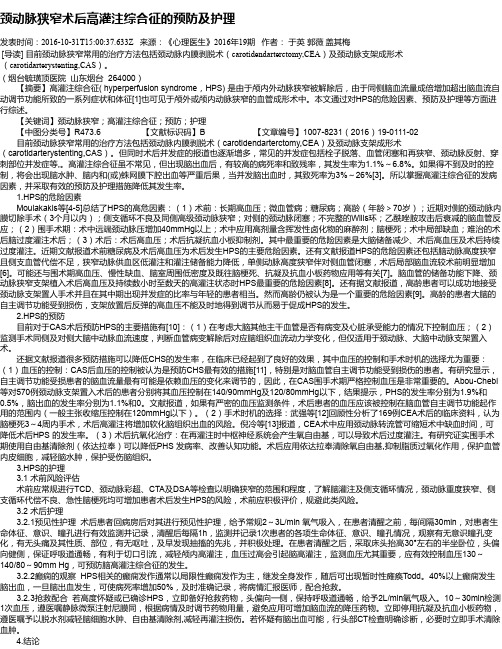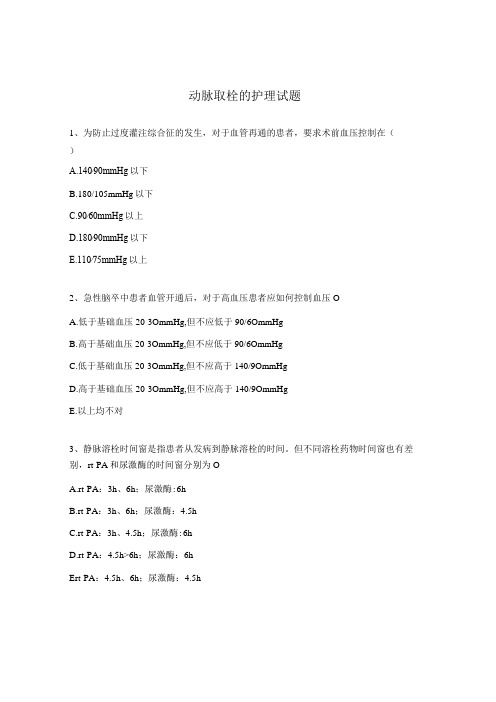过度灌注综合征
DSA下高灌注综合征的预警表现

当下围术期CHS预警手段
■ 1.术中TCD监测 ■ MCA峰值速度增加>100%,PI减低 ■ 2.CTP,SPECT,ASL ■ CBF正常增加20%-40%,增加>100% ■ 3.DSA? ■ 快速鉴定、无需对其他影像数据进行后处理
DSA下CHS的预警表现
■ 1.分支点上点状动脉扩张 ■ 2.毛细血管“红晕”样表现 ■ 3.脑静脉提前显影
■ 在慢性缺血性脑中,当灌注压力大时,小动脉和毛细血管容易破裂和出 血突然增加。这个过程解释了在全身动脉压正常的患者中发生CHS,尤 其是那些患有小血管疾病(由于慢性高血压或糖尿病)的患者。9在侧支 循环充分的患者中,小动脉和毛细血管的损害较少在慢性缺血下,因此 侧支循环可能预防
CHS机制
■ 第二,自由基的破坏。自由基会引起血管舒张并在缺血性再灌注 过程中增加脑血管的通透性。活性氧会损害脑血管内皮,导致术 后过度灌注,可通过施用自由基清除剂来预防。
术前DSA
■ 左侧大脑中动脉M1段 ■ 重度狭窄
术后颅脑CT
术前-后DSA对比—正位
术前-后DSA对比—正位
术后DSA
术后DSA—侧位
■ 第三,已经提出了压力感受器反射破坏在CHS中的作用。压力感受 器的破坏破坏了对全身动脉血压的急性变化作出反应的能力。这 些变化可能是由于对颈动脉的各种刺激(例如血管成形术,支架 放置和动脉内膜切除术)引起的
血管内治疗中的CHS
■ 1.CEA-CAS ■ 2.颅内动脉血管成形术 ■ 3.急性缺血性卒中的血管内治疗 ■ 4.其他:椎-基底动脉,锁骨下动脉,动静脉畸形
DSA下高灌注综合征的预警表现
高灌注综合征(CHS)
一.定义
急性和慢性狭窄或闭塞的脑血管重建术后的临床综合征
颈动脉狭窄术后高灌注综合征的预防及护理

颈动脉狭窄术后高灌注综合征的预防及护理发表时间:2016-10-31T15:00:37.633Z 来源:《心理医生》2016年19期作者:于英郭薇盖其梅[导读] 目前颈动脉狭窄常用的治疗方法包括颈动脉内膜剥脱术(carotidendarterctomy,CEA)及颈动脉支架成形术(carotidarterystenting,CAS)。
(烟台毓璜顶医院山东烟台 264000)【摘要】高灌注综合征( hyperperfusion syndrome,HPS) 是由于颅内外动脉狭窄被解除后,由于同侧脑血流量成倍增加超出脑血流自动调节功能所致的一系列症状和体征[1]也可见于颅外或颅内动脉狭窄的血管成形术中。
本文通过对HPS的危险因素、预防及护理等方面进行综述。
【关键词】颈动脉狭窄;高灌注综合征;预防;护理【中图分类号】R473.6 【文献标识码】B 【文章编号】1007-8231(2016)19-0111-02 目前颈动脉狭窄常用的治疗方法包括颈动脉内膜剥脱术(carotidendarterctomy,CEA)及颈动脉支架成形术(carotidarterystenting,CAS)。
但同时术后并发症的报道也逐渐增多,常见的并发症包括栓子脱落、血管闭塞和再狭窄、颈动脉反射、穿刺部位并发症等,。
高灌注综合征虽不常见,但出现脑出血后,有较高的病死率和致残率,其发生率为1.1%~6.8%。
如果得不到及时的控制,将会出现脑水肿、脑内和(或)蛛网膜下腔出血等严重后果,当并发脑出血时,其致死率为3%~26%[3]。
所以掌握高灌注综合征的发病因素,并采取有效的预防及护理措施降低其发生率。
1.HPS的危险因素Moulakakis等[4-5]总结了HPS的高危因素:(1)术前:长期高血压;微血管病;糖尿病;高龄(年龄>70岁);近期对侧的颈动脉内膜切除手术(3个月以内);侧支循环不良及同侧高级颈动脉狭窄;对侧的颈动脉闭塞;不完整的Wills环;乙酰唑胺攻击后衰减的脑血管反应;(2)围手术期:术中远端颈动脉压增加40mmHg以上;术中应用高剂量含挥发性卤化物的麻醉剂;脑梗死;术中局部缺血;难治的术后脑过度灌注术后;(3)术后:术后高血压;术后抗凝抗血小板抑制剂。
上颈椎肿瘤切除联合椎动脉搭桥患者高灌注综合征的风险护理1例

•案例报告•中图分类号R473.73 文献标识码A DOI:10.3969/j.issn.1672-9676.2023.06.031上颈椎肿瘤切除联合椎动脉搭桥患者高灌注综合征的风险护理1例基金项目:海军军医大学第二附属医院第九届护理科研项目(编号:CZYY-HLM98)作者单位:200003 上海市,海军军医大学第二附属医院骨肿瘤外科第一作者:李晓林,女,本科,主管护师,护士长通信作者:万昌丽,本科,副主任护师李晓林 万昌丽 贾齐 杨兴海 肖建如上颈椎肿瘤常累及周围重要的解剖结构,如双侧椎动脉、脊髓和颈神经根等。
当原发恶性颈椎肿瘤累及双侧椎动脉时,为了完整切除颈椎肿瘤,降低复发率,理想的治疗方法是行颈椎肿瘤切除联合椎动脉搭桥术。
椎动脉从锁骨下动脉发出,走行于颈部最终汇合为基底动脉,主要分为四段,V1段:发源于锁骨下动脉至颈6横突孔穿行;V2段:通过颈6至颈3横突孔,经颈2出枢椎,通过颈1横突孔;V3段:自颈1穿出硬脑膜处;V4段:过枕骨大孔,在脑桥延髓交接处合成基底动脉。
1995年,纽约Mount Sinai 医学中心[1]报道4例V3段椎动脉搭桥术。
1996年,Hoshino 等[2]首次报道了颈椎肿瘤切除时,牺牲结扎椎动脉。
2020年,W estbroek 等[3]报道了颈椎肿瘤手术时,椎动脉是保存还是结扎的相关处理原则,但未提及椎动脉搭桥手术。
目前为止,国内外文献尚无颈椎肿瘤累及V2段需行肿瘤切除联合椎动脉搭桥的病例报道。
2021年,我院骨肿瘤科成功开展了国际首例颈椎肿瘤切除联合椎动脉V2段搭桥手术。
术后需要行控制性降压处理,以避免高灌注综合征(cerebral hyperperfusion syndrome,CHS)的出现,当大脑处于过度灌注状态时,患者会出现头痛、血压升高、烦躁、癫痫等症状,甚至因搭桥血管连接处断裂导致意识障碍,是椎动脉搭桥患者致残致死的主要原因之一。
本例患者经过专业的治疗和精心的护理,患者术后恢复良好,未发生CHS。
精准血压管理预防烟雾病术后患者脑过度灌注综合征

入院评估患者有无便秘史,完善健康宣教及饮食指 导。术前便秘患者遵医嘱使用乳果糖15 — 30 mL 口 服,每日3次。也可术前口服麻仁丸。术日晨未排便 者予开塞露协助排便。术后便秘患者,在术前预防措 施的基础上指导患者每餐后口服养乐多100 mL,以 调节肠道菌群。为预防术后便秘发生,在病情稳定的 前提下,指导患者早期下床活动,以促进肠蠕动,注意 遵循下床三部曲。若术后第2天未排便,使用行气通 便贴,术后第3天未排便,口服缓泻剂,超过3 d未排 便,遵医嘱使用开塞露小量不保留灌肠 ,并嘱患者勿 用力排便,密切观察患者的生命体征,避免因用力排 便引起颅内压力增高导致血压剧烈变化 。④消化道 反应护理。全麻术后恶心、呕吐也是引起患者血压升 高的因素,术后常规应用奥美拉唑、泮托拉唑等胃黏 膜保护剂。如患者发生呕吐,结合患者情况分析原 因,排除颅内压增高因素后,及时对症使用甲氧氯普 胺肌内注射。及时复查血电解质,避免水电解质紊乱 引起的恶心呕吐。 1.2.2评价方法 护士长及责任组长共同设计资料 收集表,每日责任护士根据患者临床表现进行资料收 集并记录,责任组长每周汇总。CHS的具体表现⑷: ①术后2〜4 d患者出现严重头痛、恶心呕吐(排除压 迫效应)、癫痫、局灶性神经功能缺失(包括偏瘫、失 语、感觉异常等)症状;②术后血压明显高于基础血 压;③影像学检查排除新发的脑梗死、脑出血等并发 症;且手术区域局部脑血流量明显增加(超过基础值 的100% $④排除颞肌肿胀产生的压迫效应、原发性 癫痫和短暂性脑缺血发作的可能;⑤控制性降血压治 疗能够明显改善临床症状。 1.2.3统计学方法 所得数据采用SPSS19. 0软件 进行处理,采用X检验、秩和检验,检验水准* = 0 05。
①头痛护理。首先评估头痛原因,对症处理。区别 术后切口痛及颅高压或CHS引起的头痛。CHS最 常见的早期症状是同侧额颞或眶周的搏动性头痛,剧 烈头痛引起血压升高,加重脑组织过度灌注状态。对 于头痛患者,使用标准视觉模拟量表(VAS)评估疼痛 程度。如疼痛评分&3分,使用冰力降温贴贴于额 部,遵医嘱使用塞来昔布、氟比洛芬、地佐辛等药物, 必要时急查头颅CT,排除颅内出血。及时复评疼痛 评分,目标是将疼痛评分控制在3分以下。抬高床头 30。休息,降低颅内压,减轻脑水肿可能引起的头痛。 ②呼吸道护理。术后由于全麻手术、气管插管等原 因,呼吸道黏膜受损,患者可出现咳嗽、咽痛等表现, 术后病情稳定情况下嘱患者多饮水,遵医嘱联合使用 布地奈德、异丙托溴铵、乙酰半胱氨酸雾化吸入每日 2次,同时教会家属深呼吸、咳嗽排痰训练及拍背方 法,以促进痰液排出,减轻咳嗽症状。③排便护理。
取栓后脑过度灌注综合征诊断标准

一、概述取栓后脑过度灌注综合征(PRES)是一种罕见但严重的疾病,通常发生在颅内出血、颅脑创伤、急性肾衰竭、高血压急症等情况下。
该综合征的诊断标准一直备受关注,因为准确的诊断对于患者的治疗和预后至关重要。
本文旨在总结当前取栓后脑过度灌注综合征的诊断标准,以期为临床医生提供参考,为患者的诊断和治疗提供支持。
二、概述取栓后脑过度灌注综合征又称为后部再灌注综合征,是一种由于脑突发性血液灌注增加引起的病理生理过程。
该病常见于急性脑梗塞后再灌注治疗的患者,也可见于其他情况下,如脑梗塞溶栓治疗、脑出血手术后等情况。
PRES的临床症状多样,包括头痛、意识障碍、视力障碍、癫痫发作等。
PRES的诊断一直备受关注,尤其是对于取栓后PRES的诊断标准,有着较多的争议。
三、研究方法为了梳理取栓后脑过度灌注综合征的诊断标准,我们查阅了相关的文献和研究成果,并对现有的诊断标准进行综合分析和讨论。
在此基础上,我们总结了目前被广泛接受的取栓后PRES的诊断标准,以期为临床医生提供正确的诊断和治疗方案。
四、取栓后PRES的诊断标准目前,根据大量的临床实践和研究,取栓后脑过度灌注综合征的诊断标准主要包括以下几个方面:1. 临床表现根据患者的临床表现来判断是否存在PRES,包括头痛、意识障碍、视力障碍、癫痫发作等。
这些表现通常是突发性的,且在取栓后发生。
临床医生应该仔细观察患者的症状,包括疼痛的部位、性质和程度,意识状态的变化,视力的改变等。
2. 影像学检查脑部MRI和CT检查是诊断PRES的关键手段。
影像学检查通常显示双侧半卵圆中心、皮层灰质和白质的双对称性异常信号改变,包括脑水肿、小动脉痉挛、出血等。
这些影像学改变对于PRES的诊断非常重要,临床医生应该密切关注影像学检查的结果,并结合临床表现进行综合分析。
3. 脑脊液检查在排除其他潜在的病因后,部分患者可能需要进行脑脊液检查。
脑脊液检查结果通常是正常的,但有时可能出现轻度蛋白质升高等非特异性改变。
脑血管支架成形术后脑高灌注综合征

脑血管支架成形术后脑高灌注综合征刘丽;崔永强;杜娟;吴铮;林甜;于一娇;韩雪;郑雅静;蔡艺灵【摘要】Objective To investigate the clinical manifestations and pathogenesis of cerebral hyperperfusion syndrome (CHS). Methods The clinical data of 4 patients with CHS after cerebral artery stenting admittedto 306th Hospital of PLA were analyzed retrospectively. Results The 4 patients were consisted of 3 men and 1 woman whose age ranged from 43 to 77 years old. Among the 4 cases, 2 cases underwent carotid artery stenting (CAS), 1 case underwent CAS and vertebral artery stenting, and 1 case underwent basilar artery stenting. The symptoms of CHS occurred within 1 hour to 3 days after CAS. The clinical manifestations were that 3 cases with headache, 1 case with hemiparesis of right limbs, 1 cases with visual obstruction, and 1 case with coma. Head computed tomography (CT) suggested intracerebral hemorrahge in 2 cases, subarachnoid hemorrhage in 1 case, and brain edema in 1 case. After the treatment of controlling blood pressure and dehydration, 3 patients recovered and 1 patient died. Conclusion CHS is an uncommon but serious complication after CAS. Improving our understanding of CHS may assist in identifying patients at risk in order to optimize CHS prevention and management strategies. The earlier diagnosis, the earlier treatment.%目的:探讨脑动脉支架成形术后高灌注综合征(cerebral hyperperfusion syndrome,CHS)的发病机制及临床表现。
脑血管病介入诊疗并发症及其处理可编辑全文

右椎动脉V1术后15h, 滞留的造影剂消失
神经病学(第8版)
脑血管病介入诊疗并发症及其处理
一、围手术期并发症及其防治措施
4. 其他罕见并发症 ➢ 碘源性涎腺炎:以腮腺、下颌腺肿大为主 ➢ 血管源性水肿:头面部、口唇肿胀为主 ➢ 其他
应用碘佛醇后5h出现双侧颌下腺肿大(A), 11h后恢复正常(B)
神经病学(第8版)
脑血管病介入诊疗并发症及其处理
一、围手术期并发症及其防治措施
3. 造影剂脑病(contrast-induced encephalopathy) 预防和治疗:主要是补液、对症处理,对无禁忌证者可适当应用类固醇激素
右椎动脉V1狭窄术前
右椎动脉V1狭窄支架术后
右椎动脉V1术后即刻 后颅窝造影剂滞留
同一患者,不同部位(图A腿部,图B腕部 ),应用碘佛醇后第3天 出现的药物性皮炎(充血及水泡)
神经病学(第8版)
脑血管病介入诊疗并发症及其处理
脑动脉狭窄支架置入后高灌注综合征的预防及处理

脑动脉狭窄支架置入后高灌注综合征的预防及处理侯永革;刘辉;杨建芳;刘翠平;刘春生;吴明杰;朱荣彦【期刊名称】《临床误诊误治》【年(卷),期】2012(025)006【摘要】目的探讨脑动脉狭窄支架置入术后发生高灌注综合征(hyperperfusion syndrome,HPS)的危险因素、预防及处理措施.方法对我院2008年1月-2011年9月脑动脉中重度狭窄行支架置入术围术期发生HPS 8例的临床资料进行回顾性分析.结果本组术后15 min~3 h出现症状,24 ~48 h行经颅多普勒(TCD)检查示同侧大脑中动脉血流速度较术前增加110%~180%4例,基底动脉血流速度较术前增加100%~130%2例,急性闭塞大脑中动脉支架置入后恢复正常血流1例,大脑中动脉术后脑出血1例未行TCD检查.8例采取积极控制血压、脱水、清除自由基、保护脑细胞等综合治疗措施,7例痊愈出院,1例脑出血予开颅手术,但终因病情加重死亡.结论 HPS是脑动脉支架置入术后的严重并发症,手术时机的选择、术后及早识别并采取综合治疗措施是有效防治的关键.【总页数】3页(P39-41)【作者】侯永革;刘辉;杨建芳;刘翠平;刘春生;吴明杰;朱荣彦【作者单位】050011石家庄,石家庄市中心医院神经内科;050600河北行唐,行唐县人民医院神经内科;050011石家庄,石家庄市中心医院神经内科;050011石家庄,石家庄市中心医院神经内科;050011石家庄,石家庄市中心医院神经内科;050011石家庄,石家庄市中心医院神经内科;050011石家庄,石家庄市中心医院神经内科【正文语种】中文【中图分类】R743.1【相关文献】1.脑动脉狭窄支架置入术后防治脑过度灌注综合征1例报告 [J], 黄渊智;黄载文;宁世金;杨开杰2.脑血管支架种类及置入后的高灌注综合征 [J], 张选琴3.颈动脉成形及支架置入术后高灌注综合征影响因素分析 [J], 李元霄;刘昌云;陈枝挺;林汉斌4.颅内动脉狭窄支架置入术后预防高灌注综合征的护理分析 [J], 李卫月5.围术期血压变异性与颈动脉支架置入术后脑高灌注综合征的相关性研究 [J], 范秉林;何国永;李燕华;韦俊杰;肖继东;陈渊;钟维章因版权原因,仅展示原文概要,查看原文内容请购买。
动脉取栓的护理试题

动脉取栓的护理试题1、为防止过度灌注综合征的发生,对于血管再通的患者,要求术前血压控制在()A.140∕90mmHg以下B.180/105mmHg以下C.90∕60mmHg以上D.180∕90mmHg以下E.110∕75mmHg以上2、急性脑卒中患者血管开通后,对于高血压患者应如何控制血压OA.低于基础血压20-3OmmHg,但不应低于90/6OmmHgB.高于基础血压20-3OmmHg,但不应低于90/6OmmHgC.低于基础血压20-3OmmHg,但不应高于140/9OmmHgD.高于基础血压20-3OmmHg,但不应高于140/9OmmHgE.以上均不对3、静脉溶栓时间窗是指患者从发病到静脉溶栓的时间。
但不同溶栓药物时间窗也有差别,rt-PA和尿激酶的时间窗分别为OA.rt-PA:3h、6h;尿激酶:6hB.rt-PA:3h、6h;尿激酶:4.5hC.rt-PA:3h、4.5h;尿激酶:6hD.rt-PA:4.5h>6h;尿激酶:6hErt-PA:4.5h、6h;尿激酶:4.5h4、急性脑卒中患者从入院到给予溶栓治疗的时间为DNT,DNT时间越短患者获益就越大,最新指南推荐的DNT时间为OA<90minB.<3OminC.<45minD.<60min三)E<65min5、缺血性卒中由颈内动脉或大脑中动脉Ml段闭塞引起,发病儿小时内,强烈推荐机械取栓OA.3小时B.4.5小时C.6小时D.8小时E.16小时6、下列哪项符合静脉溶栓治疗并直接桥接机械取栓治疗()A.颈内动脉闭塞引起的急性脑卒中发病12小时B.大脑中动脉M4段闭塞引起的急性脑卒中发病3小时C.大脑后动脉闭塞引起的急性脑卒中发病4.5小时D.大脑中动脉Ml段闭塞引起的急性脑卒中发病3小时IJE.大脑中动脉M4段闭塞引起的急性脑卒中发病8小时7、对脑梗死病人最有价值的检查为OA.心电图B.脑电图C.颈部彩超D.头颅CTE.经颅多普勒8、脑血栓形成的最常见病因是:OA.高血压B.脑动脉粥样硬化C.各种动脉炎D.血压偏低E.红细胞多症9、朱先生,60岁,“脑血栓形成”后2周,右例J上下肢肌肉有收缩但不能产生动作,评估肌力为OAQ级B.1级C.2级D.3级E.4级10、行机械取栓时,建议患者到院至股动脉穿刺时间为()A∙≥90分钟BS60分钟C.≤90分制L正,—D.≥60分钟E.≤120分钟二、多选题1、AlS机械取栓适应征有哪些OA.年龄的三18岁(B.发病6小时内C.颈内动脉或近端大脑中动脉Ml段闭塞D.NIHSS评分工6分E.发病4.5h内接受rt-PA溶栓2、过度灌注综合征临床表现有OA.头痛B.恶心呕吐C.症状性癫痫,D.轻度意识障碍<E.言语不利3、静脉溶栓患者血压监测OA2h内15min一次(B.3-8h内30min一次(C9∙24h内1小时一次(D.3-6h内30min一次E.7-24hl小时一次4、脑梗塞病人用药指导应做到OA.遵医嘱服药B.所用药物不良反应C.根据感觉可自我调节药物用量D.动态了解血糖、血脂、血压的化E.定期门诊复查,不适时及时就诊5、急性脑卒中患者机械取栓术后的护理正确的是OA.加压包扎期间每2小时检测一次足背动脉B.术后8小时内需要饮水200OmlC.术后8小时内排尿至少80OmI以上D.术前血压控制在180∕105mmHg以下KiLJE.血管开通后,对于高血压患者控制血压低于基础血压30-6OmmHg水平6、三偏综合征是指OA.偏瘫B.偏身感觉隙碍IC.偏盲(D.失语E.失聪7、脑梗塞病人要密切监测OA.生命体征B.意识!C.瞳孔大小D.光反射E.出入量8、脑梗塞康复护理措施包括OA科学用药,预防复发确;,B.日常生活训练IC.尽早、积极地开始康复治疗(K-)D.有效调整情绪E.脑梗塞后遗症的功能恢复护理措施9、以下属于脑梗死的发病特点的是OA.多发生于60岁以上B.安静状态或睡眠中发生C.意识障碍较轻或无D.脑脊液呈血性E.有肢体运动障碍川"I2案)10、急性脑卒中血管内治疗后新发梗死的原因有OA低灌注B.抗血小板药物抵抗C.斑块脱落D.血栓形成E.血管痉挛。
不被重视或易忽视的:脑过度灌注

颈动脉重度狭窄,远端供血区低灌注
发病机制
远端动脉代偿性扩张以维持血供 长期极度扩张造成远端动脉自主调节功能耗竭
颅内血管对快速增加的CBF失去调节作用
局部高灌注造成脑水肿(血管源性)及出血
Canovas, et al. Angioplasty, Various Techniques and Challenges in Treatment of Congenital and Acquired Vascular Stenoses[book].2012,10-40. Moulakakis KG,et al. J Vasc Surg[J]. 2009,49:1060–1068 Ivens S, et al. J Neurol[J]. 2010,257:615–620。
注意:只看血管图容易误诊右侧缺血!
目前认为,术后脑血流速度较术前升高超过100%,则提示脑过度灌 注综合征。CT灌注成像(CTP)也有助于脑过度灌注综合征的诊断, Tseng等对比观察55例颈动脉支架成形术患者术前和术后CTP图像, 发现平均通过时间(MTT)与脑过度灌注综合征的发生明显相关。 平均通过时间的延长程度与颅内血管狭窄程度和脑血流量降低程度 呈正相关,脑血流量降低、平均通过时间延长和脑血容量(CBV) 轻度增加提示颅内血管扩张,脑血流自动调节机制受损,术后发生 脑过度灌注综合征的风险增加。
接下来再看看MRI图
图 2 头颅 CT,见左侧大脑半
球脑回肿胀、脑沟消失,相 图 3 头颅 CT,见左侧大
应实质呈高密度(红圈)
脑半球脑回肿胀、脑沟消失
图 4 头颅 CT,见左侧大脑半 球脑回肿胀、脑沟消失,左 大脑半球和左基底节区呈略 高密度(红圈)
图 5、6 头颅 MR FLAIR 序列,左侧大脑皮 层肿胀,呈高信号。
脑高灌注综合征的新进展

综述脑高灌注综合征的新进展王兴吴绮思肖占琴陈阳美脑高灌注综合征(cerebral hy perperfusi on syndro m e ,C H S)是以同侧头痛,高血压,癫痫,局灶性神经系统损伤,认知障碍等为主要临床表现的症状群。
常见于颈动脉血运重建术后,若不及时治疗,可能出现严重的脑水肿、颅内出血,最终导致死亡,应该引起临床医师的高度关注。
本文对CHS 的进展做一综述。
一、流行病学颈动脉内膜剥脱术(caroti d endarterecto m y ,CEA)后C H S 的发病率在不同的报道中不完全一致,范围为02%~189%,但绝大多数文献报道在0~3%。
C H S 可以发生在CEA 后前28d 内的任何时候,但是绝大多数发生在CEA 术后数小时至数天内。
二、临床表现C H S 常发生在CEA 或者支架植入术之后,最常见的临床特点是:同侧额颞部及眶周的搏动性头痛。
有时也可以表现为全头痛,眼及面部疼痛,呕吐,意识障碍,黄斑水肿,视觉障碍,部分性运动性癫痫发作且常常发展为全身性发作,局灶性神经功能缺损,颅内出血[1]。
C H S 的临床诊断是基于若干非特异性的症状和体征,易被误诊为手术期间可能发生的其他并发症,如血栓栓塞等。
三、发病机制到目前为止,CHS 的发病机制并不完全清楚,目前大家比较公认的CH S 的发病与脑血管自动调节功能受损,血管压力感受器受损,小穿支动脉灌注压骤然升高三个机制有关[1]。
有文献报道脑慢性持续低灌注及血脑屏障受损后白蛋白渗出也与C H S 发病相关[2]。
1自动调节系统的受损:血管自身调节系统的受损,这就意味着在CEA 术后随着脑血流量的增加,受损的血管自身调节系统不会对脑血流量进行调控[34]。
CEA 术后同侧大脑中动脉的平均血流速度是压力依赖性的,并且动脉压力的改变决定了血流速度及这些患者的症状。
这些发现类似于高血压脑病的发病机制[5]。
导致血管自动调节功能受损的物质可能有一氧化氮[6]、氧自由基[711]及二氧化碳[12]。
颈动脉支架术后过度灌注综合征的处理

b l o o d p r e s s u r e nd a p r o v i d i n g a p p r o p r i a t e er p f u s i o n. Ke y wo r ds : c a r o t i d s t e n o s i s;c a r o t i d a  ̄e y r s t e n t i n g;h y p e r p e r f u s i o n s y n d r o me
Di s t r i c t ,Sh a n g ha i 2 0 01 2 5,Chi na
A b s t r a c t : O b j e c i t v e T o e x p l o r e t h e e t i o l o g y , p r e v e n t i o n a n d t r e a t me n t o f h y p e r p e r f u s i o n s y n d r o m e
临 床神经外科杂 志 2 0 1 3年第 l O卷第 3 期
烟雾病行颅内外血管重建术后高灌注综合征患者的护理对策

烟雾病行颅内外血管重建术后高灌注综合征患者的护理对策摘要:目的:研究烟雾病行颅内外血管重建术后高灌注综合征患者的护理对策方法:将2020年1月-2022年12月参与本院烟雾病行颅内外血管重建术后高灌注综合征患者随机抽取80例分为两组,对照组(采用常规护理)40例,观察组(采用优质护理)40例,比较两组患者的临床护理效果。
结果:观察组的临床护理效果完全高于对照组,差异显著(P<0.05)。
观察组的血压指标也完全低于对照组,差异显著(P<0.05)。
结论:烟雾病行颅内外血管重建术后高灌注综合征患者的优质护理效果明显优于常规护理,在术中,术前、术后对患者进行优质的护理能有效改善患者的临床疾病,同时提高患者的临床护理满意度,值得临床推广。
关键词:烟雾病;颅内外血管重建术;高灌注综合征患者;优质护理随着社会的发展,各项治疗越来越合理化、科学化[1]。
烟雾病行颅内外血管重建术后高灌注综合征患者的临床治疗实施时[2],也应随着社会的发展与时俱进,以科学的、合理的、全面的护理让患者得到最优的治疗,以达到最快最佳的治疗效果,保证高灌注综合征患者最全面的恢复。
本次分析研究目的在于分析优质护理对烟雾病行颅内外血管重建术后高灌注综合征患者的影响,现将获得的研究过程、成果及数据结果报告如下:1.资料及方法1.1一般资料将我院2020年1月至2022年12月收治的烟雾病行颅内外血管重建术后高灌注综合征的患者中抽取80例作为分析对象,采用随机分配的方法将其分为对照组(常规护理)和观察组(优质护理)。
各组患者40例。
对照组患者中男女比例是25:15,最小年龄为18岁、最大年龄是55岁,年龄平均值是(41.05±6.15)岁,观察组患者中男女比例是22:18,最小年龄为19岁、最大年龄是54岁,年龄平均值是(41.15±5.25)岁。
本次研究的所有患者经过病情检测和诊断,符合烟雾病诊断标准。
经过各方面对比,无明显差异,具有合理的对比价值。
颈动脉支架术后并发症--高灌注综合征九例的护理

颈动脉支架术后并发症--高灌注综合征九例的护理朱文燕;陈燕华;古振云;马朝晖【摘要】目的:探讨颈动脉支架植入术后高灌注综合征的临床特点及护理方法。
方法回顾分析220例颈内动脉支架植入后9例出现高灌注综合征的临床资料及其护理过程,治疗方法包括适度控制血压、减轻脑水肿、监护脑血流、镇静、停用及减少抗血小板药物等综合措施,护理上予以密切观察患者血压、临床症状以及配合医师控制血压、动态复查相关检查等。
结果9例患者中,8例完全恢复出院,1例死亡。
结论高灌注综合征的护理要点是密切配合医师控制血压、保证适度的脑血流。
%Objective To analyze the clinical features of hyperperfusion syndrome occurring after carotid artery stenting, and to discuss its nursing measures. Methods Among 220 patients who received carotid artery stenting, nine developed hyperperfusion syndrome after stent implantation. Their clinical materials were retrospectively analyzed. The nursing measures, including properly controlling blood pressure, relieving brain edema, monitoring cerebral blood flow, medication with sedation drug, stopping or reducing antiplatelet therapy, close observation of blood pressure and clinical symptoms, cooperation with physicians to control the blood pressure and to dynamically make reexamination, etc. Results Of the nine patients with hyperperfusion syndrome, complete recovery was achieved in eight at the time of discharge and death due to intracranial hemorrhage occurred in one. Conclusion The key point of nursing for patients with hyperperfusion syndrome is close cooperation withphysicians to control the patient ’s blood pressure so as to ensure a proper cerebral blood flow.【期刊名称】《介入放射学杂志》【年(卷),期】2014(000)008【总页数】3页(P729-731)【关键词】颈动脉狭窄;颈动脉支架植入术;高灌注综合征;护理【作者】朱文燕;陈燕华;古振云;马朝晖【作者单位】510120 广州广东省中医院神经介入室;510120 广州广东省中医院神经介入室;510120 广州广东省中医院神经介入室;510120 广州广东省中医院神经介入室【正文语种】中文【中图分类】R743.3颈动脉支架成形术(CAS)可以减少复发性缺血性事件,但仍存在一定的的风险,其中高灌注综合征(HPS)是早期发生的严重并发症之一[1-3]。
脑过度灌注综合征

脑过度灌注综合征
关健伟;朱治山;李钢;曹黎明;乐经科
【期刊名称】《中国实用神经疾病杂志》
【年(卷),期】2011(014)008
【摘要】@@ 近二十余年,颈动脉内膜切除术(CEA)和颈动脉支架术(CAS)治疗脑血管狭窄较传统手术治疗有无可比拟的优势,它们的应用也越来越普及.脑过度灌注综合征(CHS)是该治疗不可避免要碰到的难题,虽然发生少,却能致命.从某种程度上来说,CHS已经阻碍了CEA和CAS的发展.最近关于CHS发生的机制,危险因素和预防措施等虽有不少新认识.但还有许多不太清楚和看似矛盾的地方,这些地方还有待进一步深入研究.
【总页数】3页(P94-96)
【作者】关健伟;朱治山;李钢;曹黎明;乐经科
【作者单位】广东深圳市罗湖区人民医院,深圳,518000;广东深圳市罗湖区人民医院,深圳,518000;广东深圳市罗湖区人民医院,深圳,518000;广东深圳市罗湖区人民医院,深圳,518000;广东深圳市罗湖区人民医院,深圳,518000
【正文语种】中文
【中图分类】R743
【相关文献】
1.对脑梗死DSA术后患者脑过度灌注综合征的预防体会 [J], 龚晨;陈华
2.MSCT对脑过度灌注综合征的预测、预防以及动态观察的意义 [J], 成明富;常小
娜;李松;戴美娜
3.脑过度灌注综合征研究进展 [J], 张广;朱仕逸;季智勇;周配权;徐善才;史怀璋
4.脑过度灌注综合征的辅助检查 [J], 林甜;刘丽;蔡艺灵
5.精准血压管理预防烟雾病术后患者脑过度灌注综合征 [J], 袁萍;徐博;陈璐
因版权原因,仅展示原文概要,查看原文内容请购买。
颈动脉内膜剥脱术后过度灌注综合征

颈动脉内膜剥脱术后过度灌注综合征
陈宇;吴巍巍;刘暴;刘昌伟
【期刊名称】《中国卒中杂志》
【年(卷),期】2010(005)004
【摘要】脑过度灌注综合症(cerebral hyperperfusion syndrome,CHS)是颈动脉内膜剥脱(carotid endarterectomy,CEA)术后罕见而严重的并发症.若治疗不及时,可能导致严重颅内水肿,脑出血甚至死亡.本文就CHS相关方面的最新知识作一总结,包括定义、病理生理基础、危险因素,辅助检查及治疗等,从而引起广大临床医生关注,避免CEA术后这一严重并发症的发生.
【总页数】5页(P338-342)
【作者】陈宇;吴巍巍;刘暴;刘昌伟
【作者单位】100816,北京市,北京协和医院血管外科;100816,北京市,北京协和医院血管外科;100816,北京市,北京协和医院血管外科;100816,北京市,北京协和医院血管外科
【正文语种】中文
【相关文献】
1.106例颈动脉内膜剥脱术后患者脑过度灌注综合征的预防和护理 [J], 田迎春;邱卫红;李同勋
2.颈动脉支架置入术后过度灌注综合征的危险因素分析 [J], 张尧;李永坤;蔡乾昆;包元飞;孙文;刘文华;殷勤;徐格林;刘新峰
3.颈动脉支架术后过度灌注综合征的处理 [J], 张宇一;赵明珠;朱景伟;钱忠心;刘卫
东
4.颈动脉内膜剥脱术后脑过度灌注综合征围手术期干预分析 [J], 马菲韩;杜晓亮;王胜;厉春林
5.颞浅动脉-大脑中动脉旁路移植术后烟雾病患者微血管循环时间下降与术后过度灌注综合征的相关性 [J],
因版权原因,仅展示原文概要,查看原文内容请购买。
颈动脉内膜切除术后高灌注综合征的诊断与治疗

颈动脉内膜切除术后高灌注综合征的诊断与治疗李萌;郑宇;张鸿祺;支兴龙;张鹏;焦立群;莫大鹏;华扬;凌锋【期刊名称】《中国脑血管病杂志》【年(卷),期】2005(002)008【摘要】目的探讨颈动脉内膜切除术后高灌注综合征的机制、临床表现和治疗方法.方法回顾性分析3例颈动脉内膜切除术后高灌注综合征患者的临床资料,特别是术中和术后的血压管理、经颅多普勒超声(TCD)监测脑血流速度和最终的治疗及转归.结果2例患者经严格控制血压1~3 d后,脑血流速度恢复正常,脑高灌注状态得以缓解.1例患者因血压控制不佳,导致脑高灌注状态,诱发脑出血而死亡.结论颈动脉内膜切除术后高灌注综合征有潜在的危险,经严格控制血压后,多于术后1~3 d缓解.【总页数】4页(P348-351)【作者】李萌;郑宇;张鸿祺;支兴龙;张鹏;焦立群;莫大鹏;华扬;凌锋【作者单位】100053,北京,首都医科大学宣武医院神经外科;100053,北京,首都医科大学宣武医院超声诊断科;100053,北京,首都医科大学宣武医院神经外科;100053,北京,首都医科大学宣武医院神经外科;100053,北京,首都医科大学宣武医院神经外科;100053,北京,首都医科大学宣武医院神经外科;100053,北京,首都医科大学宣武医院神经外科;100053,北京,首都医科大学宣武医院超声诊断科;100053,北京,首都医科大学宣武医院神经外科【正文语种】中文【中图分类】R651.1+2;R619【相关文献】1.老年患者颈动脉内膜切除术后的过度灌注综合征 [J], 孙勇;张佳栋;梁庆华;史锡文2.颈动脉内膜切除术后患者脑高灌注综合征发生机制及防治 [J], 武强;王涛;窦长武;刘二兵;王凯;杨继文;武文元3.醒脑静注射液联合丁苯酞胶囊预防颈动脉内膜切除术后脑高灌注综合征疗效及对缺血再灌注损伤的影响 [J], 张博; 吴琼; 焦保华4.颈动脉内膜切除术后脑过度灌注综合征影像学研究进展 [J], 张琳;何文;程令刚5.颈动脉内膜切除术后大脑中动脉流速的改变不能预测颅内出血或过度灌注综合征[J], 尹国阳;程磊;王旭;焦力群因版权原因,仅展示原文概要,查看原文内容请购买。
- 1、下载文档前请自行甄别文档内容的完整性,平台不提供额外的编辑、内容补充、找答案等附加服务。
- 2、"仅部分预览"的文档,不可在线预览部分如存在完整性等问题,可反馈申请退款(可完整预览的文档不适用该条件!)。
- 3、如文档侵犯您的权益,请联系客服反馈,我们会尽快为您处理(人工客服工作时间:9:00-18:30)。
Clinical Manifestation
• 1. Many patients complain about mild to moderate headache after CRV, while the headache for CHS are are typically severe, ipsilateral, pounding and migrainous in type, although in some patients they may be mild, intermittent, or even absent. • 2. The neurological deficit is usually cortical (e.g. hemiplegia, neglect, hemianopia, aphasia), however, symptoms for posterior circulation ischemia (dizziness, dystaxia e.g) are not common. • 3. Seizures may be focal or generalized. Features of increased intracranial tension such as vomiting are common.
Pathophysiology:Hypertension and Baroreceptor dysfunction
1. Hypertension( occurs 11% after CEA and 13% after CAS in an RCT) can significently increases CBF in impaired autoregulation. And Preoperative hypertension is the single most important determinant of development of postoperative hypertension. 2. Baroreceptor dysfunction can cause a progressive increase BP post-operatively, especially in those with contralateral stenosis. So poor collateral flow and recent (3 months) contralateral CEA are also proved to be related with CHS.
In concusion, with the remove of plaque and under the effect of HBP, a large sum of blood flow over into the brain, and breakthrough of the impaired cerebral autoregulation will happen. This will damage BBB and cause blood components exudation. Direct exposure to blood components may cause epileptiform discharge and focoal neurological deficits.
Pathology
• Descriptions for the pathology come from autopsy of those patients died of ICH induced by CHS. • Autopsy revealed changes resembled the changes seen in malignant hypertension. These changes included hypercellularity and edema of arterial and arteriolar walls. with necrosis, extravasation of erythrocytes. and exudation of fibrin
Hyperperfusion Syndrome After Carotid Revasculation (CRV)
Author:Jiao LQ
Introduction
• The two most common interventions used for carotid stenosis are carotid endarterectomy (CEA) and carotid artery stenting (CAS). • Cerebral hyperfusion syndrome (CHS) is characterised by throbbing headache, seizures with frequent secondary generalisation, focal neurological deficits, and intracerebral or subarachnoid haemorrhage. • This sydrome is underestimated in domestic, as an review of Chinese documents from 1978 to 2011 see only 100 CHS cases were reported.
Pathophysiology:normal perfusion pressure breakthrough
• This hypothesis contains three keypoints: (a)In a healthy individual, cerebral blood flow remains relatively constant while BP varies between 80-180mmHg. When BP is low, the arteriole will relax, while BP is high,it will contract. Only in scenes of malignant hypertension, perfusion pressure breakthrough can happen. (b) Chronic cerebral hypoperfusion due to critical stenosis leads to production of vasodilatory substances such as carbon dioxide and nitric oxide,causing endothelial dysfunction (c) Correction of critical stenosis causes rapid and large changes in CBF leading to vascular disruption and ICH. Extremely large increases in CBF following CEA occur only in patients with severely impaired autoregulation, even when blood pressure is normal.
Definition:Cerebral Hyperperfusion and Cerebral Hyperfusion Syndrome
1.Although cerebral blood flow and perfusion increase in almost all patients following CRV, hyperperfusion is usually defined as a 100% increase in CBF compared to the pre-operative baseline. 2. CHS is a series of “syndromes” containing headache, seizures and focal neurological deficits. 3. Hyperperfusion is seen in most cases of CHS, but symptoms can also occur in patients with only moderate increases in CBF. However, the risk of developing CHS is 10 times higher in patients with hyperperfusion than in those without. In one study, ICH developed in 3.3% of patients with hyperperfusion vs. only 0.24% of those without.
Assistant Examination: CT, MRI, Neck ultrasound, EEG
• CT or MRI can shows either intracerebral oedema or haemorrhage. EEG can demonstrate epileptiform discharge. • The most important purose for CT/MRI is differential diagnosis.,as ischemic stroke can also cause the above symptom. Besides acute carotid thrombopoiesis can also cause ischemic injury, carotid ultrosound should also be applied.
Epidemiology
• Asymptomatic increase in ipsilateral cerebral blood flow (20–40% over baseline) happens in most patients after CEA and CAS. It peaks within 24 after operation, lasts 35d. However for CHS, it often peaks at 4-5d, lasts 1-2 weeks. • Moulakakis et al reviewed 13 articals of CHS after CEA (4689 cases) and 9 articals of CHS after CAS (4446 cases) and demonstrated the incidence of CHS after CEA was estimated to occur in 1.9%, with ICH occurring in 0.37%. After CAS, CHS was estimated to occur in 1.1%, with ICH occurring in 0.74%. • CHS can also happen in other operations,such as EC-IC bypass surgery, cerebral AVM resection. A study reported as high as 15% incidence after EC-IC bypass for mymoy: Free Radicals
